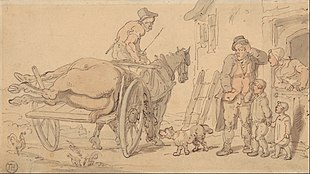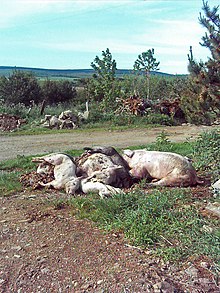
Back Wasenmeister ALS Schinda BAR Pohodný Czech Nacer Welsh Rakker Danish Abdecker German Πτωματοσυλλέκτης Greek Kadavroforigisto Esperanto Rankkuri Finnish Équarrissage (agroindustrie) French



A knacker (/ˈnækər/), knackerman or knacker man is a person who removes and clears animal carcasses (dead, dying, injured) from private farms or public highways and renders the collected carcasses into by-products such as fats, tallow (yellow grease), glue, gelatin, bone meal, bone char, sal ammoniac,[1] soap, bleach and animal feed. A knacker's yard or a knackery is different from a slaughterhouse or abattoir, where animals are slaughtered for human consumption. Since the Middle Ages, the occupation of "knacker man" was frequently considered a disreputable occupation. Knackers were often also commissioned by the courts as public executioners.[2]
- ^ Chemist, Practical (1844). "Animal Gas, or the Value of Dead Animals". The United States Practical Receipt Book: Or, Complete Book of Reference, for the Manufacturer, Tradesman, Agriculturist Or Housekeeper; Containing Many Thousand Valuable Receipts, in All the Useful and Domestic Arts. Philadelphia: Linsey & Blakiston. p. 320.
- ^ Evans, Richard (1998). Tales from the German Underworld: Crime and Punishment in the Nineteenth Century. New Haven and London: Yale University Press. p. 145. ISBN 9780300072242.
© MMXXIII Rich X Search. We shall prevail. All rights reserved. Rich X Search